
By Mike Nesbitt | Contributing Editor
The Old West Centerfires matches, put on by the Black River Buffalo Runners (a part of Capitol City Rifle & Pistol Club near Olympia, Washington), are held just six times per year.
These six matches are much alike, each one features a bullseye target at 100 yards for ten shots and then other bullseye target at 200 yards for another ten shots. That adds up to 20 shots and a possible score of 200. The reason the matches are basically all the same is because we keep accumulating scores for the year and at the ‘end of the year match’ we award additional prizes for the top aggregate scores.
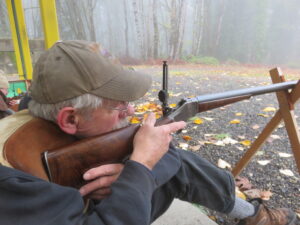
Let me add that the yearly aggregate scores are based on just five matches. This allows a shooter to miss one of the matches or to throw out their lowest score. Having the yearly aggregate simply adds to the fun and, of course, our matches are shot with the old-time buffalo rifles with black powder loads.
To have even more fun we hold and ‘after-aggregate’ match every time. The ‘after-aggregate’ match can vary, we often simply use our heavy rifles but shoot at gongs, both from cross-sticks and offhand. At other times we’ll hold a black powder revolver match, generally with .44 and 45 caliber six-guns. Or, what seems to be very popular, we’ll shoot at the gongs with our lever action “camp guns” such as the 1873 Winchesters and their copies in .44/40 caliber. To join the ‘after-aggregate’ match, each shooter pays one more dollar and the winner takes the pot.
That’s just a brief and general description of our short-range black powder cartridge matches. Now let me get more specific and put more life into this story by telling you about the match we just had.
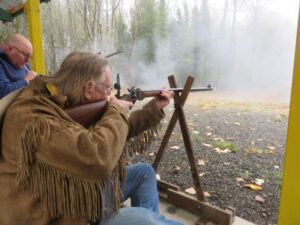
Our recent Old West Centerfires match was the end-of-the-year match where we shoot for both the match prizes and the yearly aggregate prizes, plus the after-aggregate match. We had the promise of a nice day but it was not the best morning. A thick blanket of fog covered the range, thick enough that the targets simply couldn’t be seen. At one point a couple of deer wandered out on the range and Bob DeLisle called out “Cease Fire!!” just as if we were doing some shooting. Then Bob and a couple of the other shooters chased the deer off of the range mainly because there was nothing else to do. Finally, after nearly an hour and a half, the fog lifted enough for us to fire the first relay.
Before this match I was checking loads for my .44/90 Sharps and found that my view through the mid-range tang sight was dimmer than I appreciate. My eyes do require more light than the average shooter’s eyes so I drill out the eye cups on my sights, getting more light through the larger holes. The size I was using was 3/32nds of an inch, wider than what most target shooters appreciate. Suddenly that wasn’t enough to I drilled out the eye cup to 7/64ths of an inch and with that I could see the targets better.
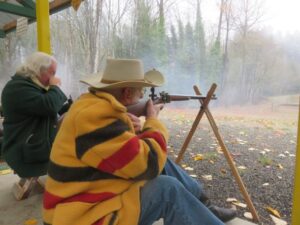
But when it became my turn to shoot in this match, in the second relay, the morning was still a bit on the dark or foggy side and I did not have as much light as I would have preferred for the best sight picture. That couldn’t be helped and I did the best I could. My ten shots at 100 yards with the big .44 Sharps weren’t all bad, I got a score of 81 on my 100-yard target.
The best score at 100 yards, shot from either the sitting or the prone position, was shot by Ken Kurfurst, shooting his newly re-build Highwall in .40/82 Crossno. That’s a modern black powder wildcat, a .45/90 with a straight taper down to .40 caliber without the slight shoulder that the .40/82 Winchester had. Ken’s score was a very good-looking group that earned him 95 points.
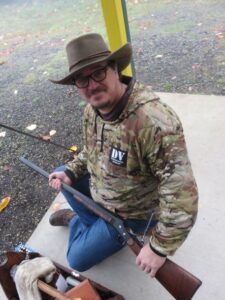
Mike Moran was shooting with us and he was using a borrowed 1874 Sharps Bridgeport Model with a 34-inch-long barrel in .45/70 caliber. Mike might have had similar troubles like mine although he’s at least 20 years younger and his score at 100 yards was an even 80 points.
And I must mention “Loco Jeff” Ritter, shooting his C. Sharps Arms 1874 Bridgeport Model in .45/90. (He got his nickname because he was a locomotive engineer but he’s just slightly crazy too.) Jeff has his rifle figured out rather well and at 100 yards he shot an enviable score of 92-X. I believe his load used 75 grains of Olde Eynsford 1F powder under a 535 grain Postell cast bullet.
Shooting another .45/90 was Doc Ritter, Loco Jeff’s son. But Doc’s rifle is a re-built Remington rolling block which was given the design of a heavy barreled buffalo gun. Seeing the custom-built rifles on the firing line certainly adds to the flavor and the variety of our black powder cartridge shooting sports, not all the rifle are the same.

The load I was using in my .44/90, which Sharps introduced in 1873, used a 480-grain cast bullet lubricated with BPC lube (Black Powder Cartridge lube, from C. Sharps Arms) over 90 grains of Swiss 1 1/2Fg powder. This was the first time I had competed while using Swiss powder and I found that it leaves a harder fouling in the bore than the Olde Eynsford powder did. So, I was wiping my rifle’s bore after every two shots in order to keep the fouling from building up and destroying my gun’s accuracy. And in between those two shots I was using the standard blow tube to blow down the bore which moistens the fouling to keep it soft. Perhaps I would have been better off if I had wiped the barrel after every shot but my wiping the bore did add time to our relay.
But soon enough my relay ended and then the first relay took “to the (firing) line” again to shoot their 200-yard targets. The targets we use for 200 yards are the standard military targets, with only the 9, 10, and X rings in the black. That can seem confusing to some spotters who call out a “9” when the shot was actually a “10.” The problem with that is such a call might lead the shooter to make an unnecessary sight adjustment. Of course, we shooters would rather hear the spotter call out with a “10” anyway!
The day had gotten brighter while the first relay shot their 200-yard targets and when it was time for the second relay again, my eyes could get a rather nice sight picture while aiming through the iron sights. Maybe my target held a score that proves my point because my 200-yard score was a 94. That pleased me very well. Even so, I didn’t have the top score at 200 yards. That honor went to Ken Kurfurst again and his score was a 94-X. At least I was close and in very good company.
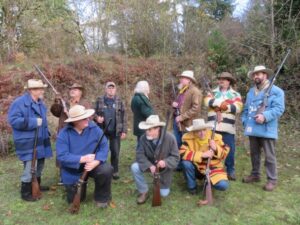
So, for this match the top five shooters with their scores out of the possible 200 were; Ken Kurfurst-189-X, Curt Lokovsek-177-5X, Loco Jeff Ritter, 177-X, Mike Nesbitt-175 (picking a large summer sausage for my prize), and Bob DeLisle-162-X. Curt Lokovsek uses an original Remington Hepburn rifle in .45/90 caliber and Bob DeLisle was shooting his Sharps by Pedersoli in .45/70. I should do another story on Bob DeLisle because he does all of his Sharps shooting while using paper patched bullets. Only the top five are mentioned here but that is certainly not to slam the other shooters who enjoyed the match with us.
After all of the prizes for this match were awarded, we went right into the awards for the yearly aggregate. Most of the names for the yearly aggregate read much like the line-up for the match because they were the top shooters for the whole year. I’ll just mention the top five again and in first place once more was Kurfurst with a year’s score of 939-18X.
Going down the line just slightly we find Lokovsek-913-17X, followed by Ritter with 901-13X, followed by me with 882-11X, and DeLisle with 844-16X. The prizes for our annual aggregate are generally goods and merchandise, the prize I picked was a copy of Mike Venturino’s fine book Shooting Buffalo Rifles of the Old West which was donated by Wolfe Publishing. Because I already have that book, I passed that on to Mike Moran, who is just getting started in this sport.
But before those awards were given out, we had another phase to our shooting match. That was the after-aggregate match and this time we shot gongs with our lever action “camp guns.” The gongs were a small buffalo at 100 yards, which we shot at from the sitting position behind cross-sticks, and the “bucket” at 50 yards where the shooting was done offhand. I can proudly say that my Uberti Model 1873 “Winchester” rifle in .44/40 did very well and with that I was able to take first place, missing only one shot at 100 yards and winning the pot.
Looking back at this black powder cartridge short-range match I must say it was really a lot of fun, even waiting for the fog to lift was fun although we would have loved it if the fog had lifted a bit faster. The best part of these Old West Centerfire matches is that they begin all over again in January for 2022. If you can, grab a black powder cartridge rifle and join us.



